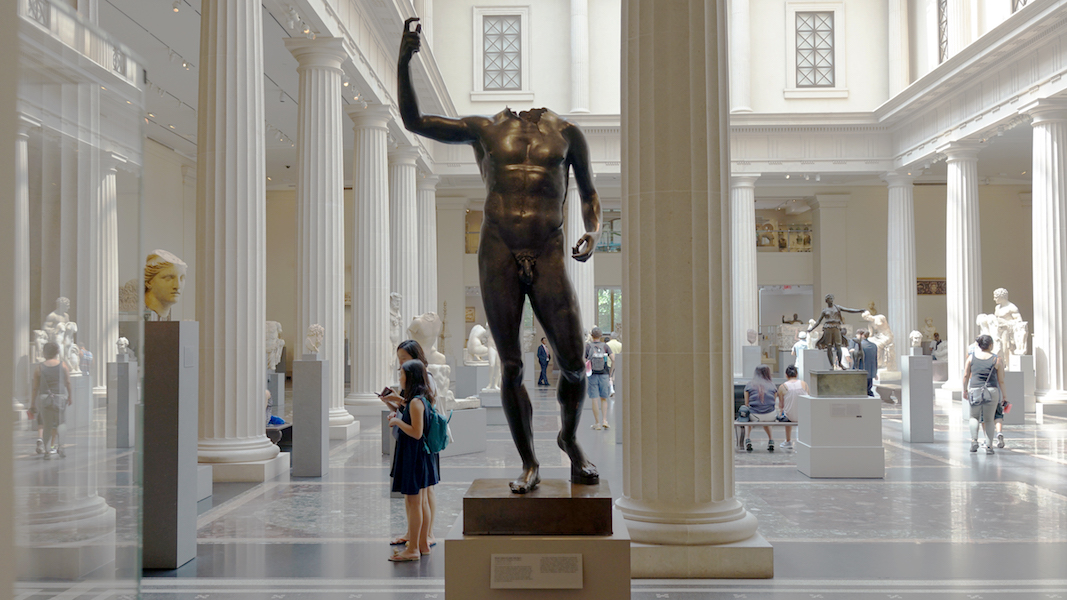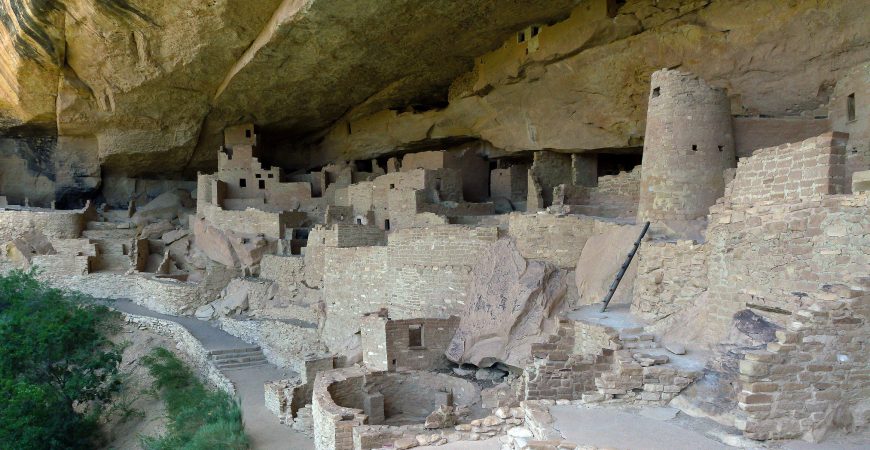
Deputy Director Abdoulaye Cisse shows a burnt manuscript at the Institut des Hautes Etudes et de Recherche Islamiques Ahmed Baba in Timbuktu, North of Mali. Thousands of manuscripts were destroyed by jihadists during the occupation, and many were hidden and saved at the Institute or by owners. Timbuktu, December 05, 2013 (photo: MINUSMA/Marco Dormino, CC BY-NC-SA 2.0). The Hill Museum and Manuscript Library is working to digitally preserve the manuscripts that were not destroyed.
The current “crisis” in cultural heritage is not a sudden development but an ongoing, complex, global problem with many causes. While it may seem simple to catch and punish perpetrators for crimes related to antiquities trafficking and destruction, in fact a lack of public understanding of the problems associated with these crimes and limited heritage-related law enforcement capacity in many countries has meant that antiquities destruction and trafficking is less likely to be prosecuted than other criminal activities (despite clear links to terrorism, international crime, money laundering, and trafficking). But there are many things that can be done on the local level to support heritage workers and caretakers and protect heritage, and there are a number of organizations that are working hard to ensure that this occurs. There are many ways that you can help.
Demand is the driver for looting and destruction
Many people are surprised to learn that legislation to protect antiquities is relatively weak or, in some cases, non-existent. Working to support and strengthen heritage protection legislation both locally and nationally, particularly when heritage is threatened by urban development or resource extraction, is one key way that ordinary citizens can contribute. There are some signs that wartime destruction is now coming under closer legal scrutiny, but most trafficked objects don’t come from wartime contexts.

Bronze statue of a nude male figure, Greek or Roman, Hellenistic or Imperial, c. 200 B.C.E. – c. 200 C.E. (The Metropolitan Museum of Art). This sculpture was likely looted from a site in Turkey.
One of the best ways for people to help save heritage is to remember that demand is the driver for looting and destruction. Governments can work to craft better legislation, prioritize better enforcement, greater funding, and vigorous prosecution for violators, but as long as there is a viable market for recently-looted antiquities, they will appear on the market. Unfortunately, the vast majority of objects sold online are looted or fake. It’s important to remember that smaller items like coins, pots, beads, or small statuary are often easiest to traffic and easiest to sell without a record of provenance (or origin), or with a faked record of provenance. For an object to be legally sold, it cannot have been recently looted and must have been in a private collection for a certain amount of time. You can find a helpful checklist here.
Incorporate the consequences of the global antiquities trade into curriculum
Education is another key way to fight destruction and looting. Many ordinary people are unaware of the threat to cultural heritage and thus, are not aware that there is a problem at all. One of the most important ways to address the problem of the ongoing loss of global heritage is to incorporate education about the costs and consequences of global antiquities trade into school curricula and university syllabi or through local outreach in community organizations, libraries, churches, or other public settings. At the secondary school or university level, cultural heritage awareness can be integrated into existing curricula in fields like Anthropology, Archaeology, Art History, Ethics, History, International Affairs, Law, and Political Science. Journalists also play a key role in spreading knowledge and awareness of what we all lose when heritage is destroyed or trafficked. If you are not sure where to begin, SAFE (Saving Antiquities for Everyone) has a wealth of resources available on their website to get you started.
When thinking about education, one problem is that the framing of heritage as a “global” or “universal” concern, while useful in many contexts, also has a significant drawback in that it can be invoked to insulate owners from the claims of source cultures. Nevertheless, the idea of “universal” heritage is commonly used by groups like UNESCO and others, and it has played a key role in the crafting of important international heritage protection legislation. Indeed, the creation of what we might call “heritage consciousness” in the global community is without question an important achievement.
Universal and local value
Some observers have pointed out that the heritage often designated as “universal” in the popular consciousness—and thus to receive the most attention when destroyed—tends to be the heritage of the ancient Classical Mediterranean or heritage associated with curated museum contexts. Meanwhile, other forms of heritage—for example currently inhabited sites of local significance or actively venerated religious locales—remain forgotten and unprotected.
The different responses to the destruction of the statues in the Mosul museum by ISIS or the Temple of Bel in Palmyra in 2014 and 2015, where both events gained worldwide headlines, versus the destruction of dozens of local mosques, churches, synagogues and other holy sites in Iraq and Syria, which received only minimal media coverage, brings this comparison into stark relief. Another recent example of this unequal extension of the notion of “universal” heritage is the nearly non-existent media coverage of the destruction of heritage-rich Yemen by a U.S. and British-backed Saudi campaign. Most outsiders are unaware of the war in Yemen at all, let alone its devastating consequences for antiquities.

Ancestral Puebloan remains and grave goods were recently reburied at Mesa Verde National Park, a result of NAGPRA, The Native American Graves Protection and Repatriation Act. Cliff Palace, Ancestral Puebloan, 450–1300 C.E., sandstone, Mesa Verde National Park, Colorado (photo: yashima, CC: BY-SA 2.0)
Some observers have pointed out that ISIS specifically made the analogy between their destruction of sites of “idol worshiping” (in the form of tombs and shrines), and museums and ancient sites—which it specifically called the heritage “idols” of the West. A similar argument was made by the Taliban in 2001, when they destroyed the Bamiyan Buddhas in Afghanistan, and by Islamist rebels in Mali, who, after destroying the tombs of Islamic Sufi saints in 2012, declared “There is no world heritage, it does not exist!” Such statements show that there are real limits to the notion of universal heritage and demonstrate that the idea of “universal heritage” can itself can be turned into a weapon.
Focus on the local
Furthermore, most looting and destruction occurs outside of wartime contexts and is focused on material that often has greater local significance than “universal” significance. It’s important to recognize that if the goal of cultural heritage protection is to preserve the objects and places that give peoples’ lives meaning and which connect them to their histories and heritage, protecting sites that are meaningful for local people is as critical as protecting famous, museum-worthy ancient sites.
While we should not abandon the idea of universal heritage altogether, a deeper emphasis on ongoing looting and destruction that occurs outside of wartime contexts would be a step in the right direction (for example, during natural disasters or as a result of resource extraction, urban development, or simple poverty). An emphasis on the value of local heritage—supported and maintained by local people with international assistance—would be similarly beneficial. Fortunately there are organizations working to do just that.
There are a number of organizations that work to raise awareness and gather information to support cultural heritage protection on the local and the international level. Some, like Eamena and the ASOR Cultural Heritage Initiatives, work to track looting and gather information via satellite and other forms of reporting with an eye toward future prosecution. Others, such as Heritage for Peace, the U.S. Committee of the Blue Shield, or the World Monuments Fund, work with governments or other entities to alert them to dangers and to craft heritage protection legislation. And several organizations, including the Penn Cultural Heritage Center and the Follow the Pots Project work to support local people and educate locally and internationally to help support and preserve culture.


